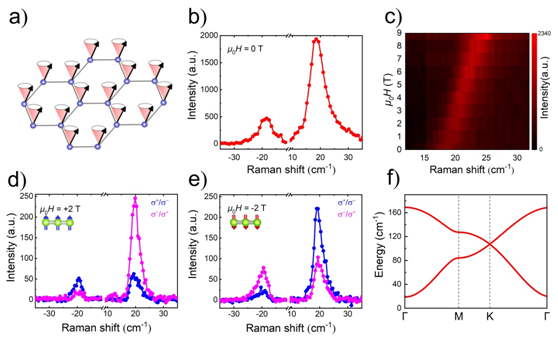Magneto-optical Raman effect provides new insights into 2D magnets
Chris Edwards 2020-09-04
The discovery of intrinsic magnetism in 2D van der Waals materials has stimulated tremendous research interest in both fundamental physics and potential information storage applications. The discovery of the magneto-optical Raman effect has puzzled researchers the world over. The microscopic mechanism and physical nature of the magneto-optical Raman effect still need to be further explored.
The Department of Physics at Southern University of Science and Technology (SUSTech) has demonstrated that helicity-resolved Raman spectroscopy is a useful tool to study the ferromagnetism in 2D magnets. It is the first time to directly probe ferromagnetism by using a Raman spectrum in a 2D magnet.
Associate Professor Mingyuan Huang and Associate Professor Li Huang have worked together to advance scientific progress in two-dimensional ferromagnetic materials. High-impact academic journal Nano Letters published their paper under the title, “Probing the Ferromagnetism and Spin Wave Gap in VI3 by Helicity-Resolved Raman Spectroscopy.” It is also the second time that Huang’s group published research results in Nano Letters this year.
Two-dimensional magnetic materials show the application prospects in making magnetoelectric storage, spin filtering, spin transistors, and other spintronics devices at extreme scales.
Scholars have also discovered unique magneto-optical phenomena in two-dimensional magnetic materials. They include nonreciprocal second-harmonic generation, helical photoluminescence, and the magneto-optical Raman effect.
The research groups independently discovered the magneto-optical Raman effect in the two-dimensional magnetic material CrI3. The magnetic order has a significant influence on Raman scattering properties of phonons. However, the mechanism of the magneto-optical Raman effect is still unclear.
The researchers studied the temperature- and magnetic field-dependent Raman spectrum of the two-dimensional ferromagnetic material VI3 resolving the structural and magnetic phase transitions. They performed the helicity-resolved Raman spectroscopy to study its magneto-optical Raman effect.
They found that the ferromagnetic order in VI3 leads to different scattering intensities to the left and right polarized light (Figure 1a). It reflects the breaking of the time-reversal symmetry. This difference will disappear after VI3 enters the paramagnetic phase.

Figure 1. Helicity-resolved Raman spectra of the dominant Ag mode in VI3 under the magnetic field
An upward VI3 generates a significantly higher s–/s– channel Raman intensity than the s /s channel (Figure 1). After an external magnetic field switches the spin direction, the scattering intensity also reverses. The Raman circular polarization represents a cycle of the magnetic field, which is direct evidence of the ferromagnetic behavior of VI3.
It is the first time that researchers have directly detected ferromagnetism through the Raman spectrum of phonons. The helicity-resolved Raman spectroscopy can be used as a simple micro-probe of its magnetic phases, and ready to be applied to other 2D magnetic materials. The above experimental phenomena have been explained clearly through first-principle calculations and magnetic point group analysis. These results have advanced the understanding of the magneto-optical Raman effect in magnetic materials.

Figure 2 Raman spectra of the acoustic magnon mode
In magnetic materials, the spin dynamics of the magnetic order can be described by spin-wave, and its frequency directly determines the ultimate switching speed of the spintronic device. The stable existence of the magnetic order in the two-dimensional limit comes from the spin-wave bandgap (also known as the acoustic magnon) (Figure 2).
In the paramagnetic state VI3, the quasi-elastic scattering signals derived from spin fluctuations were observed. The continuous spectrum gradually evolves into the acoustic magnon Raman mode as the temperature decreases. That is associated with the in-phase precession of the spins in VI3.
By combining first-principles and linear spin-wave theoretical calculations, the magnetic anisotropy of VI3 is determined to be 1.16 meV. It indicates that the ferromagnetic order is very stable in two dimensions, making it a crucial component for spintronics devices. Their improved technique provides potential pathways towards determining the ferromagnetism and other physical properties of some 2D materials.
SUSTech doctoral candidates Bingbing Lyu, Yifan Gao, and Yujun Zhang, were the co-first authors of the paper. Associate Professor Mingyuan Huang and Associate Professor Li Huang were the corresponding authors. Units involved in the research were the SUSTech Department of Physics, the Shenzhen Institute of Quantum Science and Engineering, and the State Key Laboratory of Applied Surface Physics & Department of Physics at Fudan University.
The research received funding and support from the Shenzhen Municipal Science and Technology Innovation Commission, Initiative Funds for Shenzhen High-Class University, and the National Natural Science Foundation of China. The Center for Computational Science and Engineering at Sustech supported the computational needs of the research.




